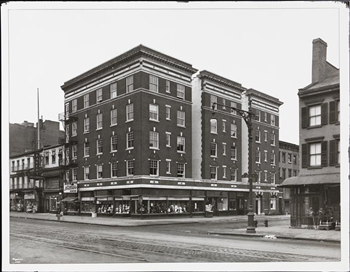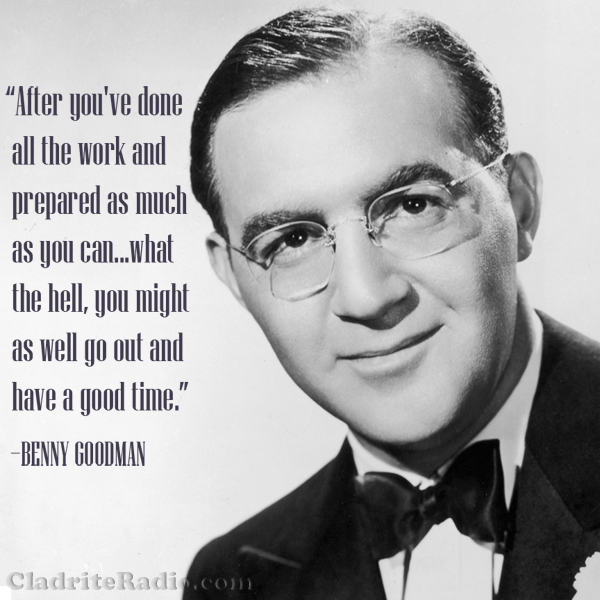Here are 10 things you should know about Benny Goodman, born 114 years ago today. Folks are still inspired to cut a rug when they hear one of his recordings. We’re featuring his music all day so tune in now!
Tag: Carnegie Hall
10 Things You Should Know About Billie Holiday
Here are 10 things you should know about the legendary Billie Holiday, born 108 years ago today. She crafted a singing style that sounded like no one else, before or since.
We’re featuring her music all day on Cladrite Radio, so tune in now!
Remembering Billie Holiday on Her Birthday
The legendary Billie Holiday was born Eleanora Fagan 107 years ago today in Philadelphia, Pennsylvania. We’re featuring her music all day on Cladrite Radio, so tune in now!

Happy Birthday, Benny Goodman!
Benny Goodman, one of the true giants of American music, was born 106 years ago today.
Known as The King of Swing, Goodman is best remembered as one of the greats of the swing era in the late 1930s and ‘40s, but he began playing professionally way back in the early ‘20s. He can be heard as part of the ensemble in some of the greatest records of the 1920s and early ‘30s.
We had the great pleasure of seeing him perform at Carnegie Hall on June 25, 1982. We’d moved to New York City just four days before, and we had no business spending the money it would cost to get a ticket, but this was just the sort of opportunity that had inspired us to relocate to the Big Apple, the chance to experience the best the world has to offer in every artistic discipline. To be in the same room with the likes of Mr. Goodman and the musicians who graced the stage with him that night—Teddy Wilson, Lionel Hampton, Panama Francis, and Phil Flanigan—as they shared their estimable gifts with the audience in that historic hall.
That was what New York meant to us then; it still does today.
After the show, we ran over to Colony Records near Times Square to buy a Benny Goodman album, with the intent of waiting by the backstage door and asking him to sign it when he came out.
That meant waiting several hours for the evening’s second show to end, but we stuck it out. Why we didn’t go find a coffee shop and have some dinner, we don’t recall. We probably thought there would be a mob of people awaiting Mr. Goodman’s appearance and figured we’d better stake out our spot as close to the stage door as possible.
But when he finally exited the Hall, there weren’t more than eight or ten people there, and he wasted no time in whisking right by every last one of us to duck into a waiting limousine.
It was disappointing, of course, that he didn’t stop to interact at least briefly with us, but hey, we can say we got to see Benny Goodman perform at Carnegie Hall and how many people can say that? What’s more, we stood not three feet from him as he exited the building and made his way home. So no regrets at all on our part, even if our LP went unsigned and our hands went unshaken.
Happy birthday, Mr. Goodman, and thanks for a wonderful evening.
There’s a small hotel
One thing we love about New York City is the through line that connects those who once lived here with the eight million residing here currently.
In our hometown of Oklahoma City, this connection is tenuous at best. It’s not that easy to find recognizable locations, sites, and structures in old pictures of OKC—it’s just not that old a town. If somehow a Oklahoma Cityan of 1910 could time travel to the present day, we’re not sure he or she would find much that was recognizable.
But a New Yorker traveling to the present from 1910, while he’d still be amazed by all the changes that had taken place, could find plenty of recognizable landmarks: The Statue of Liberty, the Flatiron Building, City Hall, Bowling Green, the Great Hall at Cooper Union, Carnegie Hall, the city’s great parks—we could go on and on.
And there are thousands of small residential buildings still in use that were around 100 years ago, too.
We recently spent a little time browsing the photography collection at the Museum of the City of New York’s web site, and we were delighted to find a 1921 photograph of the old Allerton House at 22nd Street and Eighth Avenue in Manhattan, which is right down the street from Cladrite HQ.
 |
||
| Allerton House, Southwest Corner of Eighth Avenue and 22nd Street. Byron Company (New York, NY). From the collections of the Museum of the City of New York. | ||
When we moved to this neighborhood twenty-one years ago, the Allerton was what is often referred to as a welfare hotel. Folks who were down on their luck lived there under the auspices of the city’s social services organizations. We were unfamiliar with the hotel’s history, and we sometimes wondered how that once-proud structure had come to suffer its then-current fate, just as we often mused over how the folks who resided there found themselves down on their luck.
Years passed, and the hotel was sold. It’s since been spruced up (though, thankfully, the exterior has not been noticably changed) and is now a semi-fancy hotel called the Gem.
It’s perhaps a reflection of the current economic times that the two commercial spaces on the ground floor of the Gem have remained empty, except for an occasional pop-up art exhibit, over the two or three years the hotel’s been in operation. At least when it was still called the Allerton and served as something of a timeworn sanctuary for folks trying to get back on their feet, there was a Subway sandwich shop in the ground floor.
But what we really wish was still taking up the ground floor of the Gem was the haberdashery that occupied that space in 1920. If you go to the MCNY web site, you can see an enlarged version of the picture we’ve shared with you above, and, in that hi-res version, you’ll see what we mean. The windows of the clothing are filled with men’s shirts and suits and, best of all, literally dozens of men’s hats—fedoras, bowlers, derbies, you name it.
Oh, how we wish that shop were still in operation, but of course, when we say that, what we really mean is that we wish the still-operational shop would be selling the very wares in which they were trafficking in 1920, and that wouldn’t, of course, be the case, even if the shop had somehow managed to survived all these years.
Still, one can dream, no?

